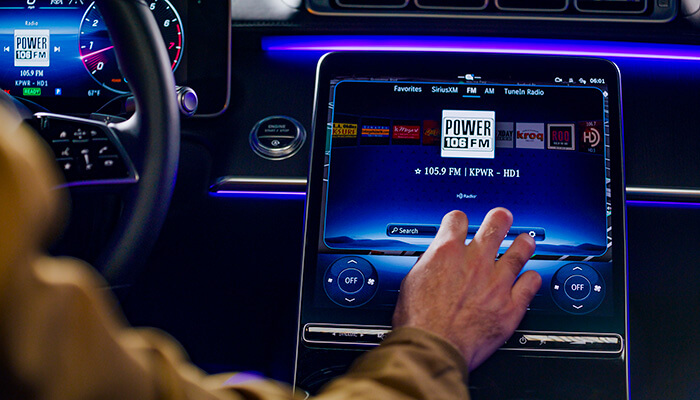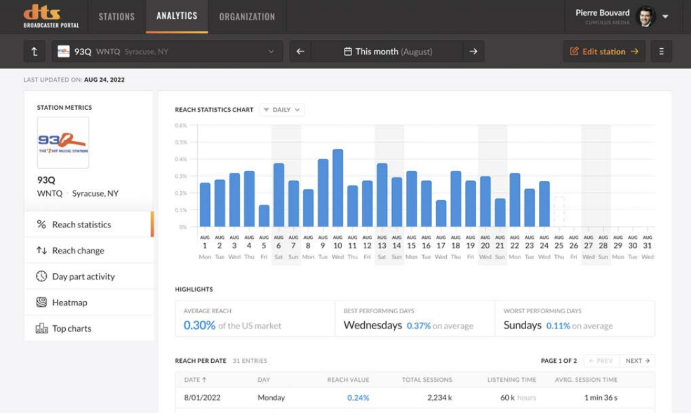Xperi on Wednesday unveiled new details about the analytics capabilities of its DTS AutoStage hybrid radio platform.
The company told radio industry executives gathered here at NAB Show New York that the insights the system will provide about listener behavior will be a major sales and analytics tool for broadcasters.
Speaking in support of that message, Pierre Bouvard, the chief insights officer of Cumulus Media and Westwood One, called Oct. 19 “a historic day” because of the unveiling of these analytics and of the radio manager’s dashboard that Xperi hopes radio managers will use to access them.
Bouvard and Xperi Senior Vice President of Broadcast Joe D’Angelo were the featured speakers at a session that kicked off the radio events of the convention.
The fact that the platform is a hybrid radio system means that while the car is receiving over-the-air radio programming, it is supplementing that with a two-way data connection online. That connection not only provides additional metadata to the car but it gives Xperi data about the user behavior.

D’Angelo said the analytics that will be available for free to stations that participate in DTS AutoStage will be a powerful complement to ratings systems like Nielsen Audio, because the data not only captures specific information about audience behavior in vehicles in a given station’s market, but is based on a huge sample size.
And the benefit will be available to broadcasters in unrated markets as well.
Bouvard described the evolving DTS AutoStage platform as providing “big data for American radio from the connected car.” Because the listener is in a vehicle, he added, the data avoids problems facing connected TV and online media platforms that sometimes count consumers who aren’t actually watching their screen or who aren’t even in the room. The Xperi data, Bouvard said, consists of “all-human audiences,” which should be an effective pitch when selling radio advertising.
The dashboard that Xperi will roll out in the first quarter of 2023 provides a radio manager with visual reports about patterns of listening to their own station. D’Angelo showed an example of a “heat map” that a station salesperson could show to a retailer to demonstrate how many cars in the client’s neighborhood are tuned to the station. He also showed a chart of hourly listening to a London station that demonstrated powerful spikes in listening when the news of the queen’s declining health and subsequent death broke.

Xperi also gave an update on its efforts to secure a foothold in the car industry. To date, Daimler and its Mercedes vehicles are the only announced automotive partners; but D’Angelo said two more major carmakers are in the process of downloading DTS AutoStage in their software updates to cars already in the field, and those names should be announced soon. He said Xperi expects to add another five carmakers in the next 12 to 24 months.
The DTS AutoStage platform is intended to be global, and D’Angelo said Xperi now has coverage in more than 100 countries, supporting over 80,000 radio stations.
As the pool of data being fed back to those stations from cars on the road scales up, he said, the system becomes more powerful. He said that Xperi has recorded more than 1.78 billion tuning/location “events” globally so far – 204 million in the United States alone – despite the limited rollout of DTS AutoStage into car models so far. As more cars come online, he said, those numbers should grow rapidly.

Participating in DTS AutoStage is free to broadcasters; the company makes its money through licensing to the carmakers. But radio stations need to provide certain information to Xperi, D’Angelo said.
[For More News on the NAB Show See Our NAB Show News Page]
That includes basic station data like call letters, name and logo; a streaming URL for the platform to switch from OTA reception to streaming when the broadcast signal fades or the car leaves the market; and live programming data including song title and artist metadata, the names of advertisers from ads, and DJ names and photos.
Until now Xperi has sought to educate the market about the technical aspects of the new platform and its current or pending features, such as seamless blending, lyrics, personalization, and recommendations for non-broadcast content that is nevertheless provided by radio broadcasters.
But the message to radio executives here in New York was that the tool has vital implications for measurement and monetization.










